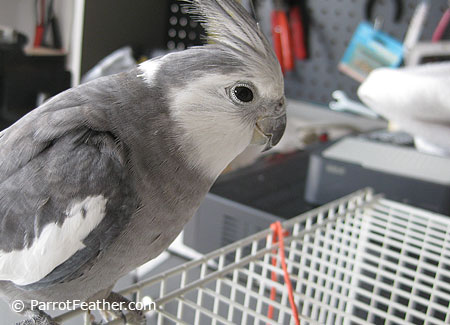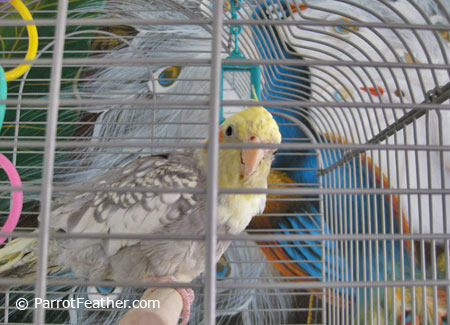Cockatiels
Common Names:
Cockatiel
Scientific Name:
Nymphicus hollandicus
Origin: Australia
Relative Size: 12-13 inches
Weight: 80-120 grams
Average Lifespan: 20 years
Egg Clutch: 2- 8
white eggs
Incubation: 18-21 days
Talking Ability: Moderate

Cockatiels as Pets
Next to the Budgie, Cockatiels are one of the most popular parrots and
widely kept throughout the world. Theses parrots are renowned for their
docile personalities and composed nature. They have so many positive
attributes that Cockatiels are quickly becoming the choice of many bird
enthusiasts and first time parrot owners. They are affordable and attractive
looking, plus many color mutations are available thanks to breeders.
If a cockatiel has been handfed and well socialized, they usually enjoy time
outside the cage with their owners. These birds are not too selective and
will sit with most family members. Shy Cockatiels can easily be won over
through food and affection. Your cockatiel will love to spend time on your
shoulder or on its play stand while you do household chores.
Not only are they known for their docile personalities, but Cockatiels are
also known for their stable temperaments. Many parrot owners have to deal
with extreme hormonal problems that will cause the parrot’s behavior to
fluctuate. Though Cockatiels may have hormonal days, their behavior is
mostly stable and predictable. This makes them better candidates for
inexperienced parrot owners and children, as long as they are supervised by
an adult.
Both males and females make great pets. There is nothing more enjoyable then
coming home to a rosy cheeked friend pacing inside his cage ready to greet
you. Cockatiels are truly lovable creatures and will go to any length to
spend time with you or gain your attention. Cockatiels are messy and at
times loud, like any parrot, but they definitely make up for it with their
sweet personalities.
Cockatiels and Biting
Like most parrots, if a foundation of proper socialization and taming techniques were not used, your cockatiel can become nippy. To help lesson the chances of your bird biting, discourage any nibbling or soft preening of the skin as a juvenile. Young Cockatiels explore with their beaks and any situation that leads to biting should be avoided. If your cockatiel decides to bite, move your hand back and ignore any biting without a reaction. Scolding the bird will not work because it only reinforces biting. Hitting or flicking the beak is not acceptable either. Parrots that experience this abusive behavior become scared and fearful of humans; as a result they will bite more. Again, if you ignore biting and continue to resume your activities as you intended, the cockatiel will forget about the encounter and the biting behavior will not be reinforced.
Training
Cockatiels can be taught to perform tricks. Though they cannot manipulate
objects with one hand, they can still wave, turn around, nod their head, or
flap their wings. More advanced tricks such as placing pennies into a
piggybank, or ringing a bell can also be taught; however, more time needs to
be invested to yield such results.
If you wish to train your cockatiel tricks, find a motivation that he is
willing to work for. Most Cockatiels eagerly work for treats or affection.
Always use positive reinforcement when training and keep sessions short and
productive. The tricks your cockatiel can learn are only limited to your
imagination and the dedication you put forth.
Talking cockatiels
Cockatiels can to talk but not with the clarity of an African Grey, Indian Ringneck, or Amazon. Males are better at talking and are much easier to understand. A male cockatiel will gladly entertain himself in front of a mirror for hours while whistling or talking. Female Cockatiels may talk, but most resort to chirping or whistling. A female cockatiel can talk if the proper time has been invested into developing her speech and if she was handfed.
Feeding your cockatiel

Your cockatiel needs to be fed a diet of seeds and pellets. Be sure to give
fresh fruits and vegetables so the cockatiel can have natural unprocessed
foods.
Cockatiels can be picky when it comes to fresh foods that are moist,
especially leafy greens, fruits, and vegetables. Most breeders will
socialize their parrots to eat vegetables and fruits as babies; however,
some will not. If your cockatiel does not eat these foods you can help by
placing a dish inside his cage filled with various fruits and veggies daily.
It can take months before the cockatiel tastes the food. Be patient and do
not starve the bird in hopes he will eat what you have offered. The bird
will eventually accept the new foods over time.
Grooming
Clipping the wings of your cockatiel is important. The wings should be
clipped twice yearly to ensure the cockatiel is limited to only a downward
glide. Caution should be used when taking your cockatiel outside and you
should practice using a leash if you do so. These birds have strong wing
muscles and can without difficulty take flight in a gust of wind with
clipped wings.
Not only do the wings need to be maintained, but the nails need to be
trimmed too. If the nails are not trimmed regularly, the bird’s mobility
will be limited. Overgrown nails will hinder the stance of the bird and
cause problems. Do not use perches with sandpaper to maintain the nails.
They have very little effect keeping the nails short.
If you do not know how to trim the nails and the wings properly, a local
qualified bird breeder or vet can do it. If careful consideration is not
used, a cockatiel can bleed to death during an improper wing clip or nail
trim.
If you do not know how to trim the nails and the wings properly, a local
qualified bird breeder or vet can do it. If careful consideration is not
used, a cockatiel can bleed to death during an improper wing clip or nail
trim.




